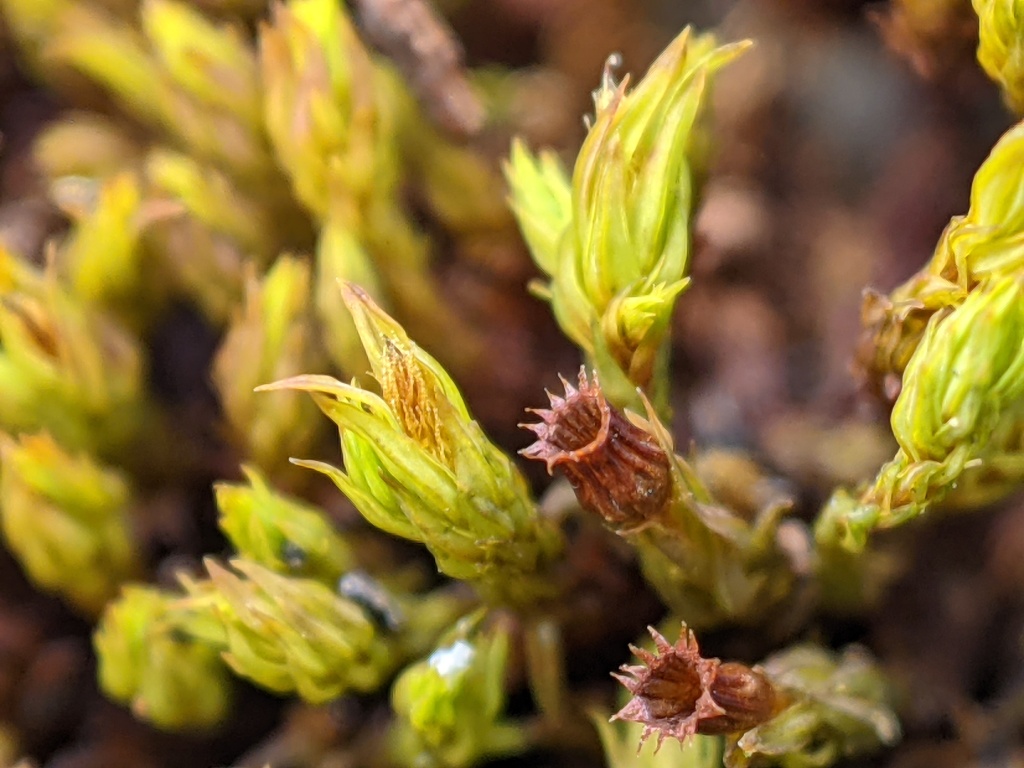Schistidium
Autoicous or rarely dioicous (not in Victoria). Asexual propagules absent. Cushions, tufts, mats or turves on rocks, trees or soil (not in Victoria). Stems erect, frequently subapically branched, with scattered rhizoids near base or stem and branches; central strand present or absent. Leaves ovate, lanceolate or rarely oblong, erecto-patent to wide-spreading when moist, appressed when dry, sometimes falcate-secund, arranged around stem and facing all direction or rarely in three spiral rows (not in Victoria); apices obtuse, acute or acuminate, with or without a hyaline hair-point; hairpoint smooth (not in Victoria) or denticulate; costae subpercurrent to excurrent; margins entire or dentate near apex, recurved, rarely plane throughout (not in Victoria) or incurved (not in Victoria), without a border; laminal cells quadrate, ovate or rectangular, smooth or papillose, with straight to sinuose walls, unistratose or bistratose at margin or in streaks or patches or throughout in apical half; alar cells not clearly differentiated. Acrocarpous. Seta straight, smooth. Capsules immersed, erect, symmetric, cylindric to campanulate or cup-shaped, with a rudimentary annulus or annulus absent. Calyptra cucullate or mitrate, not fully covering operculum, smooth. Operculum rostrate from hemispheric base, usually remaining attached to columella once dehisced. Peristome of 16 entire or variously perforated well-developed teeth, rarely rudimentary (not in Victoria) or absent (not in Victoria).
Bremer (1980a, b, 1981) monographed Schistidium and recognised a total of twelve species. In contrast, Blom (1996) revised the S. apocarpum (Hedw.) Besch. complex in just Norway and Sweden and recognised 30 species. Nuclear ITS DNA lineages have been shown to correspond with narrowly circumscribed species throughout the Northern Hemisphere, which has been used as justification by Northern Hemisphere botanists to adopt narrower species concepts in this genus (Goryunov et al. 2007; Ignatova et al. 2009). When adopting narrower species concepts, around 140 Schistidium species have been recognised worldwide. Only two species have been recognised in Australasia (Fife 2000; Klazenga 2012), but the genetic variation among the Schistidium of Australasia has not been thoroughly investigated like in the Northern Hemisphere. Two species have been recognised in Victoria.
 Spinning
SpinningBlom, H.H. (1996). A revision of the Schistidium apocarpum complex in Norway and Sweden. Bryophytorum Bibliotheca 49: 1–33.
Bremer, B. (1980a). A taxonomic revision of Schistidium (Grimmiaceae, Bryophyta) 1. Lindbergia 6: 1–16.
Bremer, B. (1980b). A taxonomic revision of Schistidium (Grimmiaceae, Bryophyta) 2 . Lindbergia 6: 89–117.
Bremer, B. (1981). A taxonomic revision of Schistidium (Grimmiaceae, Bryophyta) 3. Lindbergia 7: 73–90.
Fife, A.J. (2000). A synopsis of the New Zealand species of Schistidium (Grimmiaceae, Musci), with observations on a little known species of Racomitrium. New Zealand Journal of Botany 38: 191–204.
Goryunov, D.V.; Ignatova, E.A.; Ignatov, M.S.; Milyutina, I.A.; Troitsky, A.V. (2007). Support from DNA data for a narrow species concept in Schistidium (Grimmiaceae, Musci). Journal of Bryology 29: 98–103.
Ignatova, E.A.; Blom, H.H.; Goryunov, D.V.; Milyutina, I.A. (2009). On the genus Schistidium (Grimmiaceae, Musci) in Russia. Arctoa 19: 195–233.
Klazenga, N. (2012). Australian Mosses Online. 62. Grimmiaceae_Schistidium.


